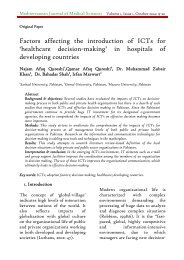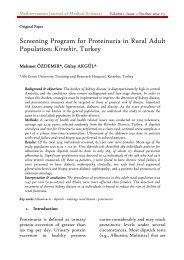Issues and Prospects of e-health in Pakistan
Background & objectives: In connection with access to information in developing countries, information flows through existing networks of communication is a main theme in the current IS literature . Methods:Information-intensive infrastructure is a requirement for information dissemination due to the shortage of network infrastructure in the majority of developing states. It is verified by many researchers that information managing technologies with their main purpose of ‘handling information’ have the advantage to enhance already existing technologies by making better information-communication a priori to new ICT innovations .Presently health information system infrastructure is deficient in resources to meet the demands and needs of increasing population in developing countries. Health care systems of developing countries have major barriers like poverty and lack of technological sophistication. Results:The basic difficulties or barriers in using information technologies include poor or inadequate infrastructure, insufficient access to the hardware and inadequate or poor resources allocation. By eliminating these barriers population health status can be improved in developing countries. Interpretation & conclusion: This study aims to determine the main issues and prospects for ehealth in the current situation of developing countries like Pakistan and the way forward for policy makers to manage all issues in future for more effective and rational decision-making in healthcare organizations. Key words: e-health; challenges; prospects; developing countries; Pakistan
Background & objectives: In connection with access to information in developing countries,
information flows through existing networks of communication is a main theme in the current
IS literature .
Methods:Information-intensive infrastructure is a requirement for information dissemination
due to the shortage of network infrastructure in the majority of developing states. It is
verified by many researchers that information managing technologies with their main purpose
of ‘handling information’ have the advantage to enhance already existing technologies by
making better information-communication a priori to new ICT innovations .Presently health
information system infrastructure is deficient in resources to meet the demands and needs of
increasing population in developing countries. Health care systems of developing countries
have major barriers like poverty and lack of technological sophistication.
Results:The basic difficulties or barriers in using information technologies include poor or
inadequate infrastructure, insufficient access to the hardware and inadequate or poor
resources allocation. By eliminating these barriers population health status can be improved in
developing countries.
Interpretation & conclusion: This study aims to determine the main issues and prospects for ehealth
in the current situation of developing countries like Pakistan and the way forward for
policy makers to manage all issues in future for more effective and rational decision-making
in healthcare organizations.
Key words: e-health; challenges; prospects; developing countries; Pakistan
Create successful ePaper yourself
Turn your PDF publications into a flip-book with our unique Google optimized e-Paper software.
Mediterranean Journal <strong>of</strong> Medical Sciences V1, I1 October 2014: 31-52 36<br />
stakeholders as an important<br />
factor (Ansari et al., 2012).<br />
Given the large <strong>health</strong><br />
<strong>in</strong>frastructure <strong>in</strong> <strong>Pakistan</strong> both<br />
public <strong>and</strong> private, supply<strong>in</strong>g to a<br />
population <strong>of</strong> 137 million people,<br />
there had been a need to build up<br />
<strong>and</strong> start a national <strong>health</strong><br />
management <strong>in</strong>formation system<br />
which is able to collect, process,<br />
analyze <strong>and</strong> provide criticism on<br />
all <strong>health</strong> related data <strong>in</strong>clud<strong>in</strong>g<br />
<strong>in</strong>formation on <strong>in</strong>put, process <strong>and</strong><br />
output <strong>in</strong>dicators (Gururajan et<br />
al.,2008). The national feedback<br />
reports on the new HMIS admit a<br />
slow development <strong>in</strong> scope <strong>and</strong><br />
report<strong>in</strong>g reliability, but also note<br />
the cont<strong>in</strong>ued need for<br />
improvement <strong>in</strong> the quality <strong>and</strong><br />
usage <strong>of</strong> <strong>in</strong>formation at various<br />
levels. A study carried out <strong>in</strong> 2000<br />
po<strong>in</strong>ted out that the <strong>in</strong>formation<br />
produced via HMIS was unrelated<br />
<strong>and</strong> the data did not help<br />
managers to make decisions<br />
(Bhutto et al., 2010).<br />
M<strong>in</strong>istries <strong>of</strong> Health are<br />
approv<strong>in</strong>g Computer S<strong>of</strong>tware <strong>in</strong><br />
order to get better <strong>health</strong> data<br />
collection, stretch, storage,<br />
analysis <strong>and</strong> distribution <strong>in</strong> their<br />
Health Information Systems<br />
(Khoja et al., 2008). Computer<br />
s<strong>of</strong>tware are obta<strong>in</strong>ed through<br />
various means <strong>in</strong>clud<strong>in</strong>g buy<strong>in</strong>g<br />
on-shelf s<strong>of</strong>tware, <strong>in</strong>denture based<br />
s<strong>of</strong>tware, <strong>and</strong> donated s<strong>of</strong>tware.<br />
Most <strong>of</strong> the S<strong>of</strong>tware acquired<br />
through these means is not<br />
distributed with their source codes<br />
<strong>in</strong> that they are proprietary<br />
s<strong>of</strong>tware. However, the data<br />
elements <strong>of</strong> Health Information<br />
Systems are chang<strong>in</strong>g regularly<br />
due to chang<strong>in</strong>g disease patterns;<br />
<strong>in</strong>com<strong>in</strong>g <strong>and</strong> outdated drugs, <strong>and</strong><br />
chang<strong>in</strong>g <strong>health</strong> policies (Ishtiaq<br />
et al., 2012).<br />
As s<strong>of</strong>tware requires to be redesigned<br />
from time to time to take<br />
on chang<strong>in</strong>g requirements arises<br />
there is a need to th<strong>in</strong>k about<br />
efforts on open source s<strong>of</strong>tware.<br />
With Open Source S<strong>of</strong>tware<br />
development method, the<br />
s<strong>of</strong>tware is distributed with their<br />
source code which means that a<br />
M<strong>in</strong>istry <strong>of</strong> Health can uphold its<br />
s<strong>of</strong>tware with no unique<br />
developers (Mostafa et al., 2011).<br />
The characteristics <strong>of</strong> Open<br />
Source S<strong>of</strong>tware development<br />
approaches seems to be<br />
appropriate <strong>in</strong> develop<strong>in</strong>g<br />
s<strong>of</strong>tware for Health Information<br />
System <strong>in</strong> that <strong>health</strong> <strong>in</strong>formation<br />
systems <strong>in</strong>stitutions has full<br />
access to their s<strong>of</strong>tware source<br />
codes <strong>and</strong> thus can br<strong>in</strong>g <strong>in</strong> any<br />
changes accord<strong>in</strong>g to their<br />
requirements <strong>in</strong>stantly. In the<br />
case, the M<strong>in</strong>istry has no ICT<br />
capacity (say human resources) to<br />
be able to change the s<strong>of</strong>tware; the<br />
s<strong>of</strong>tware can be restructured by<br />
any computer expert <strong>and</strong> not<br />
©2014 Mediterranean Center <strong>of</strong> Medical Sciences








